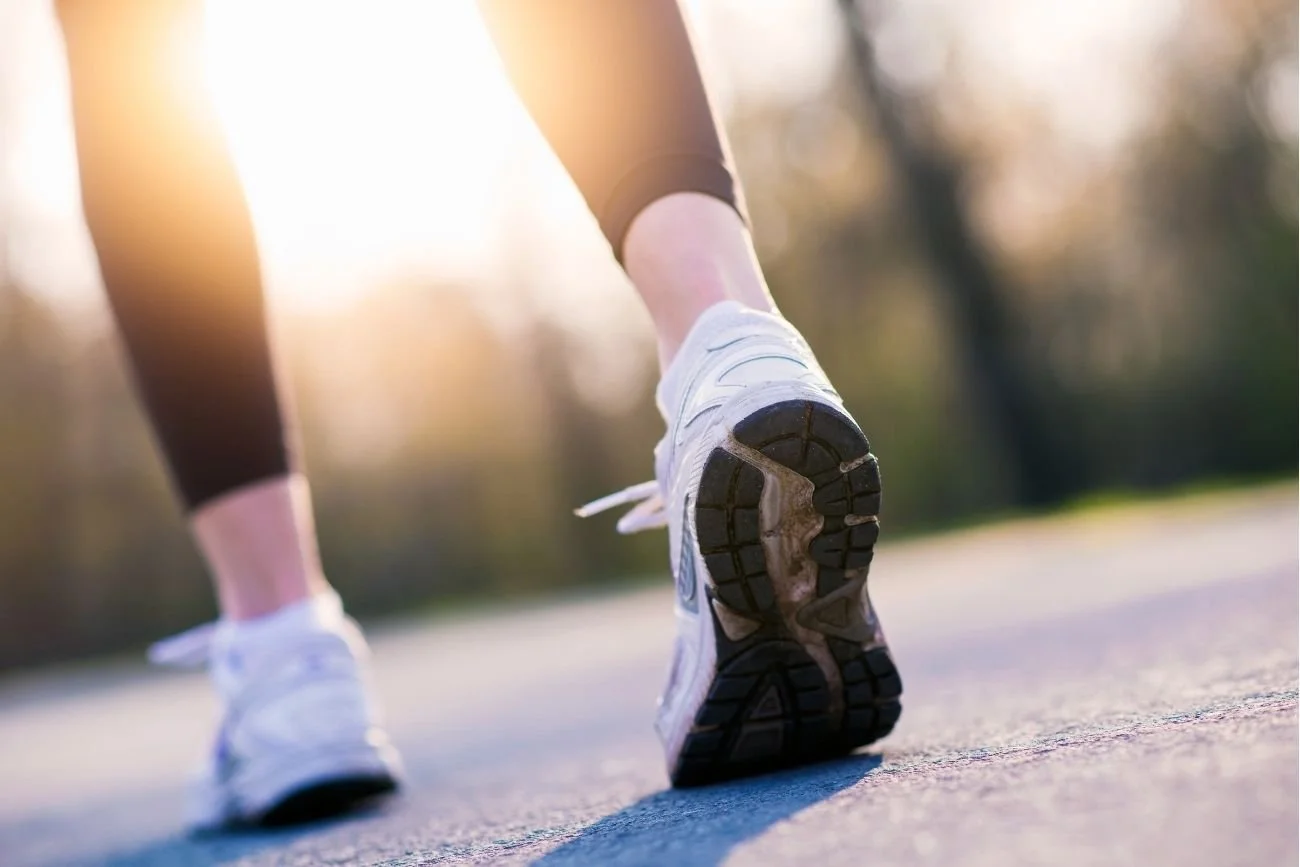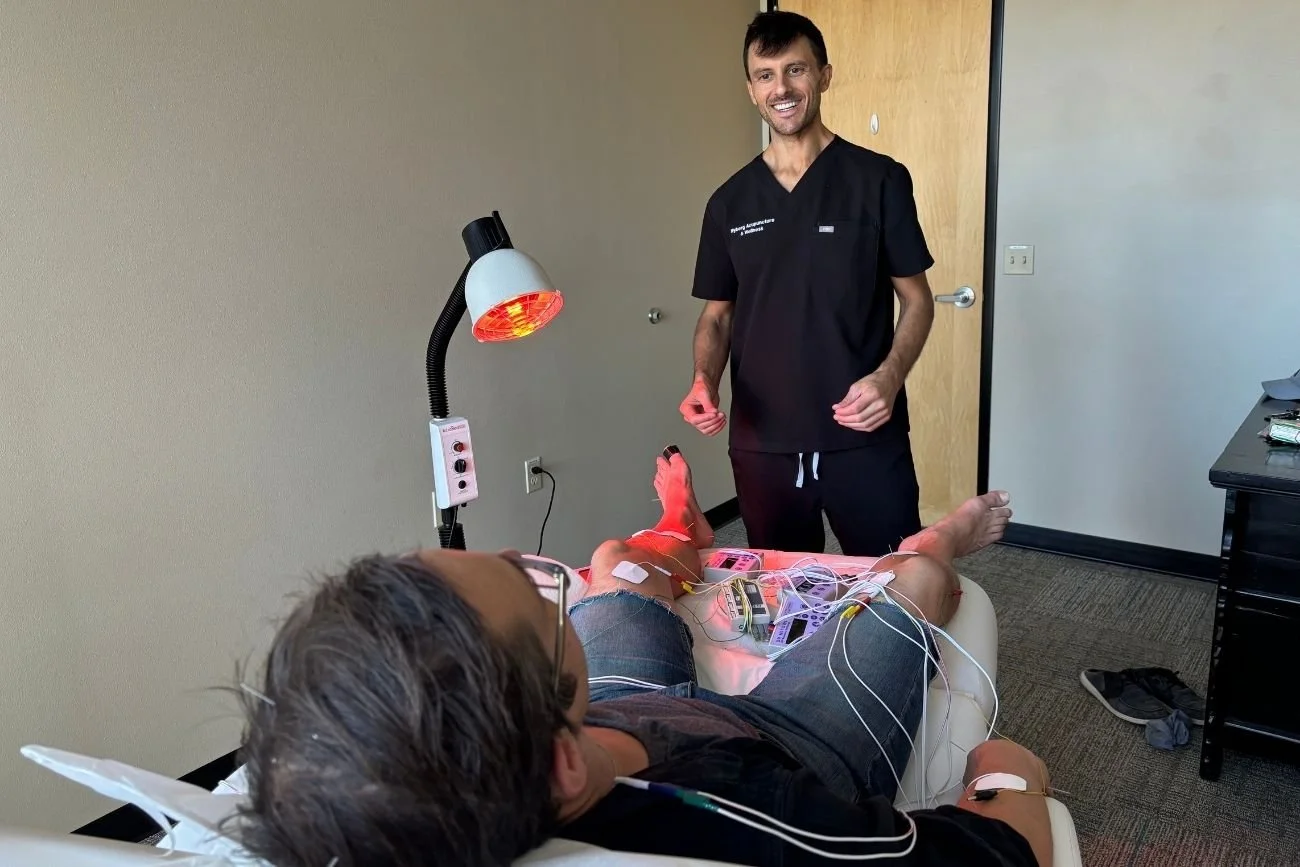Top Exercises for Neuropathy Relief and Better Balance
If you’re living with neuropathy, you already know how much it can change your daily rhythm. The steady, confident way you used to walk feels uncertain. Mornings that once started without a second thought about your feet or legs can begin with tingling, burning, or numbness that follows you through the day. It’s easy to lose confidence in movement when every step feels unpredictable.
What many people don’t realize is that the right kind of movement can help calm those sensations and retrain the nervous system. Evidence shows that targeted exercises for neuropathy can reduce pain, strengthen weak muscles, and restore the body’s sense of balance and control.1 Gentle activity supports circulation, stimulates nerve pathways, and helps the brain and muscles reconnect more efficiently.2
Even small, consistent steps matter. With the right plan, movement becomes more than physical therapy. It becomes a pathway to feeling steady, strong, and capable again. For more on how nerve health can improve through treatment, explore our approach to neuropathy care.
In this guide, you’ll learn which exercises offer the most benefit for neuropathy, how to perform them safely, and why balance, proprioception, and gentle strength training are key to long-term nerve health.
Exercise for Neuropathy: Why Movement Matters
Exercise benefits neuropathy in several ways. Aerobic activity enhances blood flow to the extremities, delivering oxygen and nutrients that help protect and repair nerve fibers. Strength training preserves muscle tone and joint stability, which improves mobility and balance. Flexibility and coordination exercises keep the body responsive, helping prevent stiffness and falls. Together, these forms of movement create the conditions the nervous system needs to function more efficiently and reduce pain over time.1,2 For more on how Nyberg Acupuncture & Wellness combines acupuncture and ATP Resonance BioTherapy® to support nerve repair, reduce pain, and improve mobility, read Can Acupuncture Help Neuropathy?
Regular, guided exercise also supports nerve communication. As circulation improves and muscles are reactivated, the body sends stronger, clearer signals between nerves and the brain.1 These signals help restore proprioception, the body’s sense of position and movement, and reinforce the feedback loops that make walking and standing feel more secure.
Research indicates these effects across multiple trials. Trials show movement-based therapies can improve nerve conduction, balance, and muscle coordination while easing neuropathic discomfort.1,2 The key is to start with small, achievable activities performed consistently. Even short bouts of movement can lead to meaningful progress when done safely and regularly.
By understanding how exercise works on a neurological level, people living with neuropathy can see it not as a task but as a treatment. Each repetition, stretch, and step provides sensory input that strengthens nerve pathways and restores confidence in motion.
Balance and Proprioception Exercises for Neuropathy
One of the most common and disabling effects of neuropathy is a loss of balance. When nerves in the feet and ankles lose sensitivity, the brain receives less information about body position. This disrupts proprioception, the body’s ability to sense where it is in space, and increases the risk of unsteadiness or falls.
Research shows that specific sensorimotor and gait exercises can retrain this feedback loop. In a randomized controlled trial, participants who practiced eight weeks of balance and gait training showed measurable improvements in proprioception, nerve function, and muscle activation in the legs and lower back compared to those who received standard education alone.3
Studies show the nervous system can adapt with repeated practice. Simple, focused balance drills help reestablish communication between the feet, ankles, and brain.
Examples of balance and proprioception exercises:
- Supported single-leg stance: Stand near a wall or sturdy chair. Lift one foot slightly off the ground and hold for 10 to 20 seconds. Switch sides. Repeat 3 to 5 times per leg. Gradually reduce hand support as confidence improves.
- Heel to toe walk: Walk in a straight line, placing the heel of one foot directly in front of the toes of the other. Keep eyes forward and move slowly. This challenges balance and coordination.
- Tandem stance with head turns: Stand with one foot directly in front of the other. Slowly turn the head side to side while maintaining posture. This activates both balance and vestibular reflexes.
- Toe and foot strengthening: Strengthen toe control and ankle stability using a resistance band or a tool such as the ToePro platform, which has been shown to improve balance by up to 35 percent in six weeks.4 Balance retraining is a core pillar of our neuropathy care. Learn how it integrates with nerve-focused treatment in acupuncture for nerve pain relief.
These exercises retrain neural pathways by stimulating sensory receptors in the feet and legs. They also encourage better core engagement, which supports posture and control during walking. Over time, the goal is not only to stand still without wobbling but to move through daily life with renewed stability and confidence. This work is especially helpful when nerve damage is tied to diabetes or chemotherapy.
Water Therapy and Low-Impact Exercises for Neuropathy
Water provides one of the safest and most effective environments for movement when living with neuropathy. The natural buoyancy reduces joint stress while offering gentle resistance that strengthens muscles and improves circulation. The warmth of the water also relaxes tight tissues and enhances blood flow to the feet and legs, which can help calm nerve discomfort and stiffness.
Clinical research supports these benefits. In a randomized controlled trial, patients who participated in aquatic physiotherapy showed greater improvements in walking ability, balance, and pain reduction than those performing land-based exercises.5 The water’s resistance helps activate muscles without overloading weak or painful joints, while its support allows individuals with limited stability to move with confidence.
Examples of low-impact and water-based exercises:
- Water walking: Walk forward and backward in waist-deep water for 5 to 10 minutes. Keep posture upright and take slow, controlled steps to improve strength and coordination.
- Leg lifts with support: Hold the pool’s edge. Slowly lift one leg to the side, then lower. Repeat 10 to 15 times per leg. This strengthens the hips and improves lateral balance.
- Heel and toe raises: Stand on the pool floor and rise up onto your toes, then lower onto your heels. Perform 10 to 15 repetitions. This improves calf strength and ankle control.
- Floating balance drills: With a flotation belt or pool noodle for support, practice gentle knee lifts or side-to-side movements. These stimulate proprioception and engage core stability.
Aquatic therapy is especially useful for those who find weight-bearing activity uncomfortable or tiring. The water reduces the risk of falls and provides constant sensory feedback to the skin and muscles, which helps retrain the nervous system. Regular practice can improve endurance, confidence, and the ability to transition to land-based activity over time.
Tai Chi and Yoga for Neuropathy Relief
Gentle movement practices such as tai chi and yoga have been shown to improve balance, reduce nerve pain, and enhance quality of life for people living with neuropathy. These disciplines combine slow, intentional motion with controlled breathing and focus, which together promote better communication between the brain, nerves, and muscles.
Tai chi, in particular, is supported by long-term clinical research. In a study of adults with peripheral neuropathy, consistent tai chi practice led to improvements in physical performance, stability, and lower limb sensation.7 The rhythmic weight shifting and controlled transitions help strengthen the ankles and improve proprioception while keeping joint stress low.
Yoga provides similar benefits through stretching, strengthening, and mindful breathing. A 2023 systematic review found that yoga can reduce neuropathic pain and improve functional mobility by lowering stress responses and increasing body awareness.8 The combination of movement and breath helps regulate the nervous system, reduces muscle tension, and improves circulation to peripheral nerves.
Here are some beginner-friendly mind-body movements to try:
- Seated mountain pose: Sit upright with feet flat on the floor, lengthen the spine, and rest hands on thighs. Inhale to lift the chest, exhale to relax the shoulders. This posture supports alignment and breathing control.
- Gentle seated cat-cow: While seated, alternate between arching and rounding the spine. Move slowly with the breath. This increases flexibility and circulation in the spine and core.
- Tai chi weight shifts: Stand with feet shoulder-width apart. Slowly transfer weight from one foot to the other, keeping knees slightly bent. This trains proprioception and lower body stability.
- Tree pose with support: Stand near a wall or chair for balance. Place one foot lightly against the inner calf or ankle of the opposite leg and hold for 10 to 20 seconds. This strengthens the feet and engages postural control.
The goal of these practices is consistency rather than intensity. Just a few minutes of mindful movement each day can help calm nerve sensitivity and build steadier control. Over time, these small sessions can enhance balance, confidence, and overall well-being. If you’re interested in exploring mindfulness techniques for pain relief, visit our article on mindfulness for chronic pain.
Safe Strength and Seated Exercises for Neuropathy
Strengthening exercises play a key role in restoring stability and coordination when neuropathy causes muscle weakness. When nerves do not transmit signals effectively, muscles can lose tone and endurance. Over time, this affects balance and walking confidence. Gentle, structured strength training helps reestablish nerve-to-muscle communication and supports joint protection.
In a controlled trial, patients with peripheral neuropathy who participated in sensorimotor and gait training significantly improved muscle activation, proprioception, and nerve function compared to those who did not exercise.3 Consistent strengthening of the legs and feet enhances these same systems, helping the body respond more effectively to uneven surfaces or quick movements.
Seated and supported exercises make it possible to build strength safely without adding pressure to painful or numb areas. These movements also reduce the risk of falls and make exercise accessible to those with limited balance or stamina. For more simple home strategies that complement in-office care, try these at-home self-care tips for neuropathy.
Here are several safe strengthening exercises to try:
- Seated leg extensions: Sit tall in a chair with feet flat on the floor. Slowly extend one leg until the knee is straight, hold for two seconds, then lower. Repeat 10 to 15 times per leg. This strengthens the quadriceps and improves walking ability.
- Seated marches: While seated, lift one knee toward the chest, then lower and alternate sides. Perform 10 to 20 repetitions. This activates the hip flexors and improves coordination.
- Calf raises: Hold onto a counter or back of a chair for support. Rise up onto the balls of your feet, pause, then lower back down. Perform 10 to 15 repetitions. This builds calf strength and ankle stability, important for balance.
- Ankle flex with resistance band: Secure a light resistance band around the ball of one foot. Point and flex the foot slowly against the band’s resistance. Repeat 10 times per foot. This strengthens the ankle and improves circulation.
- Toe curls and spreads: Place a towel flat on the floor. Curl the toes to scrunch the towel, then release and spread them wide. Repeat several times to engage the small muscles of the feet that support balance.
Begin with short sets and focus on slow, controlled movement rather than intensity. Over time, these exercises can help improve mobility, walking stability, and overall muscle endurance. When done consistently, even low-resistance work signals the nervous system to stay engaged and responsive.
A Simple 10-Minute Routine to Get Started
Try this short sequence to gently stimulate circulation, improve balance, and wake up the muscles that support your movement:
- Seated marches: 1 minute
- Ankle flexes with resistance band: 1 minute per foot
- Heel to toe walk (with support): 2 minutes
- Seated cat-cow or spinal roll: 2 minutes
- Calf raises: 2 minutes
- Gentle standing balance hold: 2 minutes
Even short sessions like this can make a noticeable difference when practiced regularly. Once you feel comfortable, your provider can help you build toward longer routines or add more advanced movements. For condition-specific guidance, review diabetic neuropathy in the feet or chemotherapy-induced neuropathy and discuss next steps with your healthcare provider.
Frequently Asked Questions About Exercising with Neuropathy
-
Yes, most people with neuropathy can safely exercise when the plan is tailored to their ability and comfort level. Always check with your healthcare provider before starting. Begin with gentle, supported movements to avoid strain or falls.
-
Low-impact movement that supports circulation, balance, and strength (such as walking, water therapy, tai chi, or seated strengthening) tends to be most effective. The key is consistency rather than intensity.
-
Research shows that regular movement improves blood flow, nerve signaling, and muscle activation, all of which support nerve health over time. Exercise cannot always reverse damage, but it helps the nervous system function more efficiently and reduces discomfort.¹ ²
-
If numbness or burning pain makes activity difficult, start with seated or water-based exercises. These provide stability and reduce pressure on sensitive areas while still improving circulation and nerve communication.
-
Results vary, but many people begin to feel steadier and experience less discomfort within a few weeks of consistent practice. Small, regular efforts add up to meaningful progress over time.
Bringing It All Together
Living with neuropathy does not mean living with constant discomfort. Regular, guided movement through balance training, gentle strengthening, stretching, and mind-body exercise can help reduce pain, improve coordination, and restore confidence in your body. Each small effort contributes to better circulation, stronger muscles, and clearer nerve communication over time.
Progress may feel gradual, but every step matters. Celebrate the moments when your balance feels steadier or the tingling in your feet lessens. These are signs that your nerves are responding and your body is beginning to heal.
When you are ready to explore additional support, reach out to schedule a consultation. At Nyberg Acupuncture & Wellness, our specialized peripheral neuropathy program combines acupuncture and ATP Resonance BioTherapy® to help reduce pain, improve nerve function, and restore comfort and mobility. Together, we will develop a treatment plan that builds on your self-care efforts and helps you move toward lasting comfort, stability, and function.
Learn more about our approach to neuropathy care or call +1 (503) 336 4747 to book your consultation.
References:
- Zhang YH, Hu HY, Xiong YC, et al. Exercise for Neuropathic Pain: A Systematic Review and Expert Consensus. Front Med (Lausanne). 2021;8:756940. doi:10.3389/fmed.2021.756940
- Leitzelar BN, Koltyn KF. Exercise and Neuropathic Pain: A General Overview of Preclinical and Clinical Research. Sports Med Open. 2021;7(1):21. doi:10.1186/s40798-021-00307-9
- Ahmad I, Verma S, Noohu MM, Shareef MY, Hussain ME. Sensorimotor and gait training improves proprioception, nerve function, and muscular activation in patients with diabetic peripheral neuropathy: a randomized control trial. J Musculoskelet Neuronal Interact. 2020;20(2):234-248.
- The Foundation for Peripheral Neuropathy. Brain-Based Balance Exercises. Published May 2, 2024. Accessed November 9, 2025. https://www.foundationforpn.org/brain-based-balance-exercises/
- Zivi I, Maffia S, Ferrari V, et al. Effectiveness of aquatic versus land physiotherapy in the treatment of peripheral neuropathies: a randomized controlled trial. Clin Rehabil. 2018;32(5):663-670. doi:10.1177/0269215517746716
- Li L, Manor B. Long term Tai Chi exercise improves physical performance among people with peripheral neuropathy. Am J Chin Med. 2010;38(3):449-459. doi:10.1142/S0192415X1000797X
- Bhardwaj P, Ahuja N, Parchani A, Singh S, Sethi D, Pathania M. Yoga as a complementary therapy in neuropathic pain: A systematic review and meta-analysis of randomized controlled trials. J Family Med Prim Care. 2023;12(10):2214-2222. doi:10.4103/jfmpc.jfmpc_2477_22








